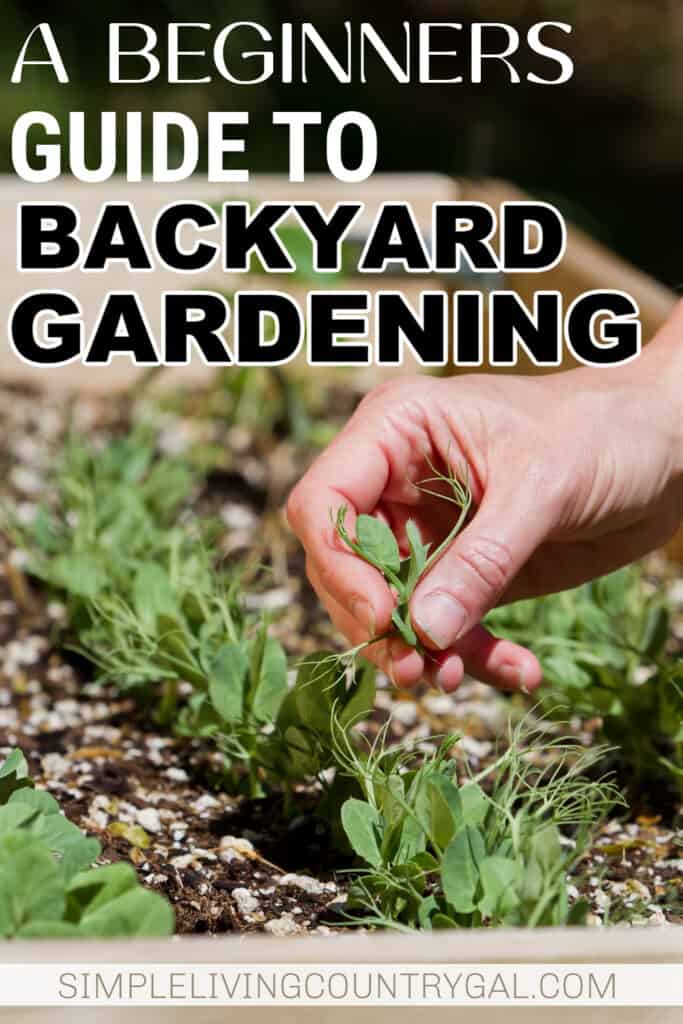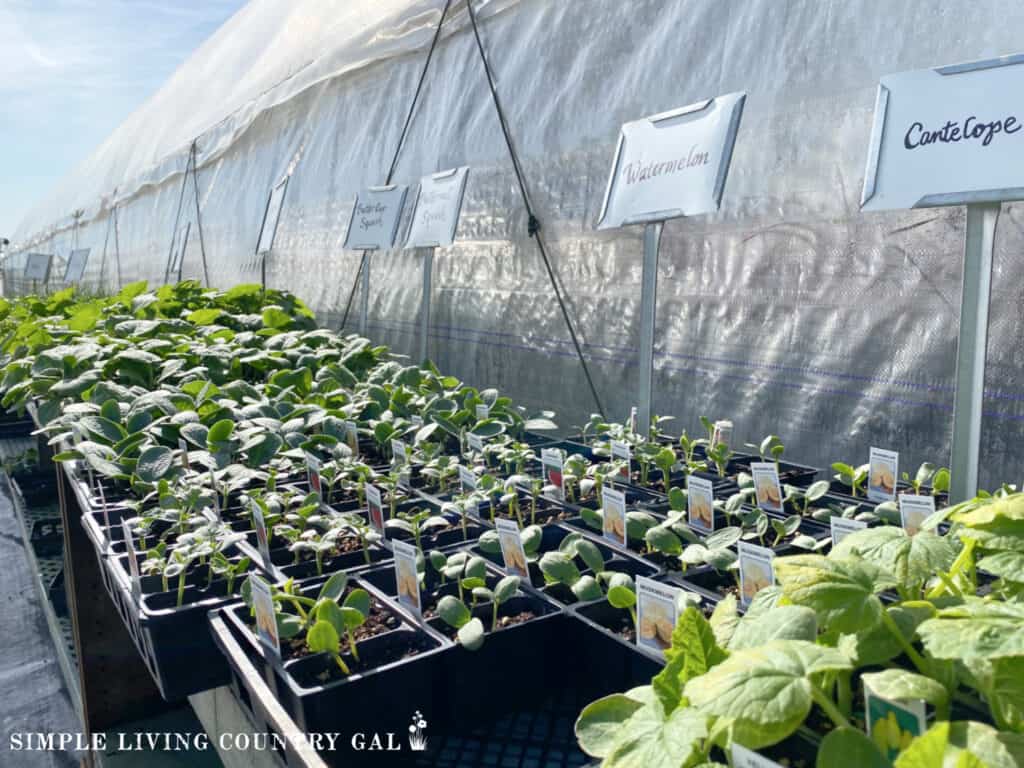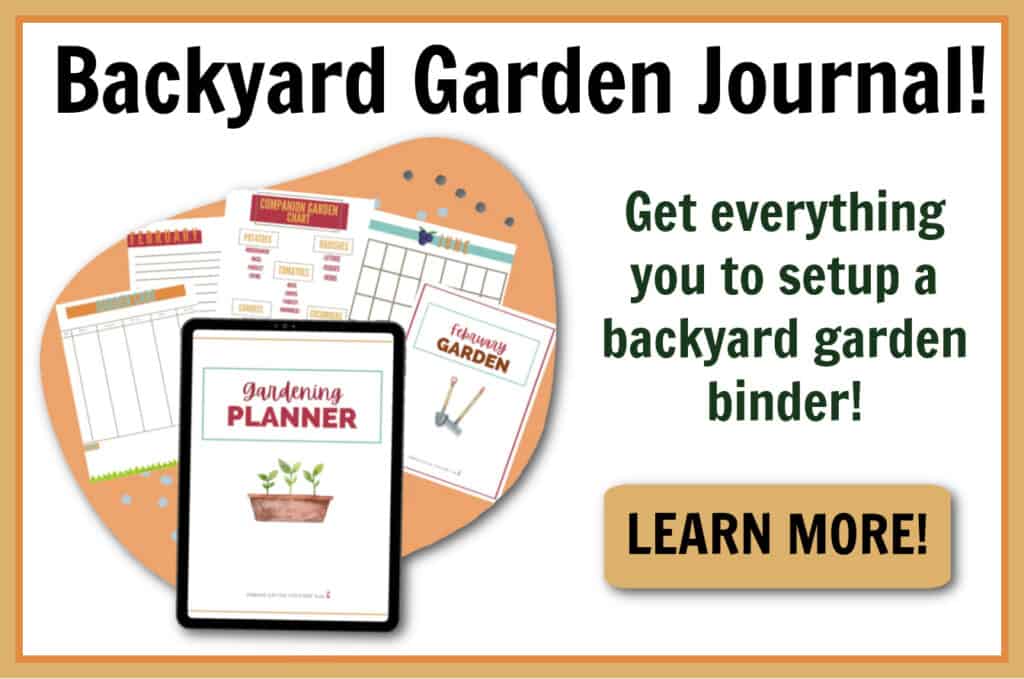starting my first garden
So, you want to start growing veggies in your own backyard? Great! I am here to help with a guide on all the things you need to consider, decide, and prepare. This step-by-step guide on starting my first garden will get you moving in the right direction.
How to start a backyard garden for the very first time with confidence, growing the foods you love right outside your kitchen door.

Starting your own backyard garden can be an exciting and rewarding experience. Not only does it allow you to grow your own fresh, organic produce, but it also gives you more control over your health.
If you are new to gardening, the idea of starting a vegetable garden may seem daunting and overwhelming. And if you are not careful you may find yourself in over your head. Leave a store with just a handful of seeds and you may find yourself in teh same boat I was years ago after planting a 20 foot by 40 foot garden.
Things to know before starting a new garden
- You do not need to plant the entire packet of seeds. Plant enough to feed your family so you are not overwhelmed by the idea of caring for too much.
- You do not need to toss unused seeds. Seeds will actually keep for 3-5 years allowing you to buy seeds this year for your next 2-3 gardens.
- Gardens take work. Work to plant, work to tend, and most importantly work to harvest. Keep this all in mind as you mapping out your garden size.
What is the best garden layout for beginners?
When it comes to setting up your first garden, the layout is key. It not only determines how efficient and productive your garden will be, but it will also determine if growing your food will be enjoyable or more of a chore. For beginners, it’s best to start with a simple and straightforward layout that is easy to maintain and gives the most sun throughout the day.
- Raised Bed Garden – One popular option is the raised bed garden, where you can easily control the soil quality and drainage.
- Traditional Garden – Another popular option is the traditional row garden, where crops are planted in long rows with pathways in between for easy access.
- Container Garden – If you have limited space, a container garden is a great option. You can use any type of container or pot to grow your vegetables, making them versatile and easy to move around.
No matter which layout you choose, make sure to keep in mind the location of your garden in relation to sunlight and water sources as well as protection from garden eaters such as rabbits or deer.
More on Garden Layouts:
Starting My First Garden – Prep Work
Before you start digging there are a few things to figure out. Let’s go over the most important.
#1. How Big of a Garden Do You Need?
This depends on a few factors such as how much space you have available, what vegetables you want to grow, and how many people you are looking to feed. As a beginner, it’s best to start small and manageable. You can always expand your garden in the future if needed.
Single Person – If you are looking to grow enough vegetables for one person, a raised bed garden or container garden measuring 4×4 feet should be sufficient.
Small Family – For a small family of 2-3 people, aim for a larger raised bed garden or multiple containers with at least 25 square feet of space.
Large Family – For a large family of 4 or more, consider a traditional row garden with at least 50 square feet of space.
Empty Nester Couple – If you are an empty nester couple, a smaller raised bed or container garden should be enough to provide fresh vegetables for two people.
READ: What is an Average Garden Size?
#2. What Vegetables Should You Grow?
The best vegetables to start with are those that are easy to grow and provide high yields. Some beginner-friendly options include:
Tomatoes, cucumbers, carrots, lettuce, and herbs like basil and mint. It’s also a good idea to grow vegetables that you actually enjoy eating.
READ: First-Time Gardener Vegetables
#3. When Should You Plant?
The best time to plant your garden depends on your location’s climate and the specific vegetables you are growing. Some vegetables, like peas and lettuce, can be planted early in the spring while others, like tomatoes and peppers, should wait until after the last frost. Do some research on the specific vegetables you want to grow and their ideal planting times for your area.
You can use this helpful tool at the Farmer’s Almanac. Just put in your zip code and you will get a basic timeline of when to plant the most common vegetables and fruit.
#4. Where Should You Plant?
In addition to choosing what type of garden you will have, it’s important to consider where in your yard or outdoor space you should plant it. Vegetables need at least six hours of direct sunlight per day, so choose a spot that gets plenty of sun. You’ll also want to consider access to water and make sure your garden is in a convenient location for watering.
Additionally, pay attention to the soil quality in the area you plan to plant and consider implementing raised beds or containers if necessary. Lastly, think about any potential pests or animals that may be attracted to your garden and take measures to protect your plants.
#5. Should You Plant Seeds or Seedlings?
Both seeds and seedlings have their benefits when it comes to starting your vegetable garden. Seeds are generally cheaper and give you more control over the growing process, but they also require time and effort to nurture into mature plants.
Seedlings, on the other hand, are already partially grown and can be easier for beginners to manage. However, they may be more expensive than seeds and you may have less variety to choose from. Ultimately, the decision between seeds or seedlings will depend on your personal preference and gardening experience.
#6. Where Should You Purchase Your Seeds or Seedling?
There are several options for purchasing seeds or seedlings for your vegetable garden. You can find them at local nurseries, gardening centers, or even online. It’s important to do some research on the specific varieties of vegetables you want to grow and choose reputable sources for your seeds or seedlings. Additionally, consider supporting local businesses by purchasing from nearby nurseries or farmers’ markets.
You can also save money by purchasing from seed exchanges or joining community gardening groups where members share seeds and seedlings with each other. Whether you choose to buy from a store or through a community, make sure to carefully read instructions for planting and caring for your chosen plants.

#7. What are the essential tools needed for a successful first garden?
While it’s easy to get carried away with all the different gardening tools available, there are a few essential tools that every beginner gardener should have.
These include:
- A shovel or spade
- A hoe
- Hand trowel
- Garden gloves
- Pruning shears
- Watering can or hose
- A rake
- Wheelbarrow or wagon
- Gardening fork
It’s also important to have proper storage for your tools, such as a shed or designated space in your garage, to keep them organized and prevent damage.
More Garden Tools:
Starting My First Garden – Step-by-Step
Now that you have done the ground for planning and prepping, it’s time to get into the ground and prep things for growing.
#1. Map Out Your Garden Layout
Before planting, it’s important to have a clear idea of how you want your garden to look and where each plant will go. This not only helps with organization but also ensures that plants are placed in areas with the right amount of sunlight and space. You can use graph paper or an online garden planner tool to map out your layout.

#2. Prepare The Soil
The soil is the foundation for a healthy garden, so it’s important to make sure it’s in good condition. Test the pH level of your soil and add any necessary amendments to ensure that it has the right balance for optimal plant growth. This could include adding compost, fertilizer or lime.
#3. Plant Your Seeds or Seedlings
Follow the instructions for each type of plant and make sure to water them immediately after planting. For seeds, it’s important to keep them moist but not soaked until they sprout. For seedlings, gently loosen the root ball before placing them in the ground and watering thoroughly.
If you want a full guide on how to grow each type of plant, yes…every one! You can find our full collection here: How to Grow Guides.
#4. Water Regularly
Water is essential for plant growth, so it’s important to have a regular watering schedule. This will depend on the type of plants and the climate in your area. In general, it’s best to water in the morning or evening when the sun is not as strong to prevent evaporation.
READ: How to Water Your Garden
#5. Mulch and Weed
Mulching helps retain moisture in the soil and also prevents weeds from growing. Apply a layer of mulch around your plants, making sure to leave a small space around the stem. Regular weeding is also important to prevent weeds from competing with your plants for nutrients.
#6. Fertilize as Needed
Plants require certain nutrients to thrive, and fertilizing can help supplement any deficiencies in the soil. Make sure to use organic fertilizer and follow the instructions for each type of plant. Over-fertilizing can be harmful to your plants, so it’s important to use the recommended amount.
#7. Monitor and Maintain
Regularly check on your garden for any signs of pests, diseases, or nutrient deficiencies. Address any issues immediately to prevent them from spreading and causing harm to your plants. Also, continue with regular maintenance tasks such as pruning, staking, and deadheading to keep your plants healthy and thriving.

#8. Harvest and Enjoy
The best part of gardening is harvesting the fruits (or vegetables!) of your labor. Make sure to monitor your plants for when they are ready to be harvested, as each plant has different signs. Once you have harvested, enjoy your fresh produce in meals or share with friends and family.
#9. Expand Your Knowledge
Gardening is a continual learning process, and there is always something new to discover. Take the time to research different plants, growing techniques, and gardening methods to expand your knowledge and improve your gardening skills. You can also join local gardening clubs or attend workshops and classes to learn from experienced gardeners. Remember, the more you know, the better equipped you will be to create a thriving and beautiful garden.
Starter Vegetable Gardens, 2nd Edition: 24 No-Fail Plans for Small Organic Gardens


Tips for Caring for Your Vegetable Garden
Maintaining a healthy vegetable garden requires regular care and attention. Here are some tips to help keep your plants happy and productive:
- Water deeply and consistently, making sure the soil is moist but not waterlogged.
- Mulch around plants to retain moisture and suppress weeds.
- Keep an eye out for pests and diseases, using natural methods of control when possible.
- Rotate crops each season to prevent nutrient depletion and disease build-up in the soil.
- Fertilize regularly with organic fertilizers to provide essential nutrients for plant growth.
- Prune and train plants as needed to promote healthy growth and fruit production.
- Harvest regularly to encourage continued production and prevent overripening or spoilage.
Gardening can be a rewarding and fulfilling hobby that not only provides fresh and nutritious produce but also allows for creativity, relaxation, and connection with nature. With the right knowledge, tools, and care, anyone can become a successful vegetable gardener. So grab your gardening gloves and get ready to dig in! And remember, don’t be afraid to get your hands dirty – that’s all part of the fun of gardening.




